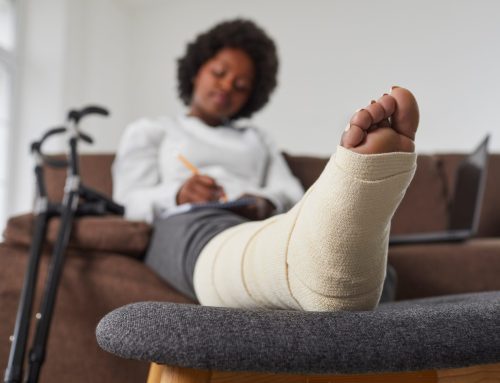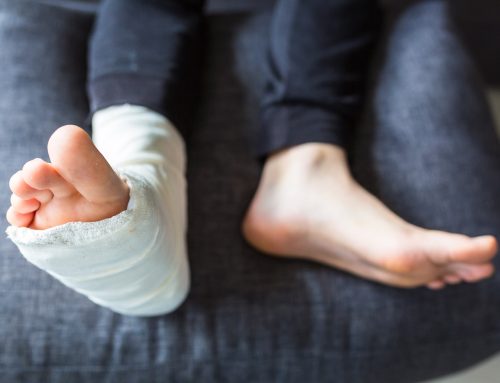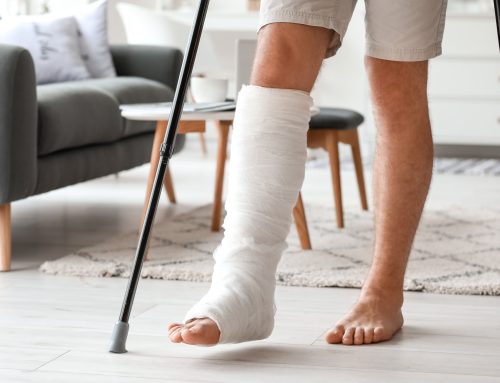Yikes, we hope you’re reading this for fun, not because you or a loved one are suffering from a broken arm. Whatever the case may be, you can find yourself with a fracture from a number of causes. This could include:
- A fall
- An accident
- A sports injury
- The impact of an object
- And more

Depending on the severity of your fracture, you may need a splint, brace, cast, or even surgery in order to heal your broken arm properly. Don’t worry, this common injury accounts for 50% of all broken bones in adults (and second in children, behind the collarbone). That means as long as you’re proactive and follow your doctor’s recommendations, you’ll be in good shape soon. Here’s what you can expect for a broken arm’s treatment and recovery process.
Broken Arm: Treatment and Recovery
Believe it or not, your arm only has 3 bones. This includes the humerus, which connects your shoulder to the elbow, and your radius and ulna, which are in your forearm that connects to your wrist. Common breaks happen from placing weight or landing on an outstretched hand, getting hit by a heavy object (such as a baseball), or being in an accident involving direct force, like a car crash. The first step in your treatment process is figuring out what type of break it is to determine the best treatment plan.
What to expect from your diagnosis
If you’ve suspected you’ve broken your arm due to pain, swelling, or a deformity, you’ll want to see your doctor immediately. If your bone has broken through the skin, head straight to the emergency room.
During your diagnosis, your doctor will examine the injury site. They’ll ask you about your pain, what led to the injury, and observe the swelling. If they suspect a fracture, they’ll order an X-ray to find out exactly where the break occurred and the severity of it. If the bone has pierced through the skin, you’ll likely require surgery and treatment right away.
Setting the bone
Here comes the uncomfortable part – setting the bone. If your X-ray shows that your fracture isn’t aligned, your doctor will need to set the bone for it to heal correctly. If this step is missed, you may end up with a deformity at your injury site.
Your doctor will determine if you need medication before setting the bone due to the pain and swelling you’re experiencing.
Immobilization
For the next few weeks, you’ll undergo an immobilization period. Your doctor will likely do routine X-rays to see how it’s healing and give you a list of activities you can and can’t do. It’s crucial that you listen to these recommendations to have faster fracture healing and avoid complications.
Sometimes you’ll need to wait 5-7 days for the swelling to go down before you can make use of a cast, splint, or brace.
Medication and pain management
It’s normal to experience pain during the initial stages of the healing process. Over time, new nerves will form that will also cause you to experience a bit of discomfort. However, if you have severe pain after 7 days, this may be a red flag that you have an infection, or it’s not healing properly. If this happens, you should consult your doctor immediately.
For the first few days, your doctor may prescribe medication to help reduce inflammation and ease the pain. Just keep in mind that you shouldn’t be driving, making important decisions, or going to work if you’re on a medication that acts as a sedative. These types of medications can be addictive and should only be used under your doctor’s recommendations.
Physical therapy
Since your arm has been healing in an immobilized state, it’s going to be pretty stiff. Physical therapy helps reduce and manage this symptom and improves muscle strength as your broken arm continues to heal. Your therapist or doctor may recommend some exercises at different stages of the healing process to help you regain your pre-injury abilities.
With or without physical therapy, you can also experience faster healing by 38% with a non-invasive ultrasound device. It depends on the type of fracture you have, so you may want to contact an expert to ensure it’ll benefit you.
Possible complications
Typically, a broken arm is nothing to worry about once you’ve received a treatment plan. However, there are some complications you should look out for. If you notice any of these signs, you should immediately contact your doctor:
- You’re experiencing chills or a fever.
- You have numbness or tingling.
- Your pain isn’t getting better with physical therapy.
- You’re still feeling weak and stiff several months after the injury.
- Your hands or fingers turned a tint of blue.
Typical recovery timeline
Your recovery time will largely depend on the fracture site, severity, and how well you take care of it. Small fractures in your upper arm can heal in as little as 8 weeks, whereas more complicated breaks can take 12 or more. You may even need 6-12 months of physical therapy to feel as good as new. Be patient with your body as it recovers from this traumatic experience, and be thankful that you’re able to heal with time.
By adopting good lifestyle habits, such as consuming enough calcium, eating healthy, and avoiding smoking and alcohol, you’re giving your body its best chance at a faster recovery. It can be frustrating when a broken arm slows you down and disrupts your routine. If you want to take control of your health, learn more about how ultrasound technology is helping Canadians heal faster.
Are you currently recovering from a broken arm? Have you had one in the past? What was the healing process for your fracture like? Share your story with our readers that want to know more.





